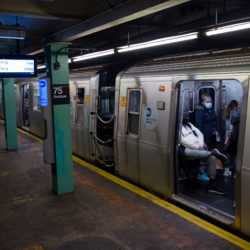One of the facilities at the subway system’s massive Coney Island yard, which is vulnerable to climate events due to its low elevation and its proximity to water. Wikimedia photo by Wuse1007
Much of Brooklyn, a borough surrounded by water on three sides, is vulnerable to extreme weather events. According to official maps, Coney Island, Manhattan Beach, Sheepshead Bay, Gerritsen Beach, Floyd Bennett Field, Mill Basin and nearby areas are all in a “flood zone,” as are the areas around Red Hook, Gowanus and the Navy Yard.
Parts of the borough, including its transit system, have suffered due to extreme climate events, not only during Superstorm Sandy but during the more recent Hurricane Ida this past September. During this storm, for example, Brooklyn’s Newkirk Avenue subway station, which is below ground but not covered by the street, was not only flooded, but tiles came off the walls.
According to a new report by New York State Comptroller Thomas DiNapoli, the MTA needs to publish a new assessment of its long-term capital needs that pays particular attention to the growing threat climate change poses to transit, and its most recent 20-year needs assessment shows many capital needs are overdue for attention.
To prepare for the release of its five-year capital programs, the MTA creates a 20-year capital needs assessment detailing long-term infrastructure priorities for maintaining and improving its system. The last assessment, covering 2015-2034, was published in 2013 and is overdue for an update. The MTA is now required by state law to produce a needs assessment every five years starting in 2023.
The MTA’s 2013 assessment did not include any recovery and resiliency work beyond what was already planned to recover from Superstorm Sandy and mitigate against similar storms. Climate change impacts are intensifying and the increased risk of flooding, storm surges and other damage to transit need to be incorporated into the plan as soon as possible before the October 2023 deadline to inform public debate and ensure targeted investment, Di Napoli said.

Although the 2013 assessment is out of date, it serves as a measuring stick for the MTA’s capital investments and its progress in maintaining the safety and reliability of its assets. DiNapoli’s report notes that in some areas — such as important upgrades to stations, tracks and switches — the MTA either has gone beyond its 2013 assessed needs or is near meeting its targets, but in many others, the MTA has barely addressed important goals:
- Subway flooding is increasingly disruptive and destructive, yet since 2015 the MTA has only spent $56 million on pump rooms and other line equipment with another $189 million committed, out of the $1.7 billion called for in the needs assessment for 2015 through 2024.
- The MTA said it needed to invest $4.9 billion in new subway cars from 2015 through 2024, but it only spent $700,000 on subway car projects since 2015. It did order 460 subway cars during its 2015-2019 capital program — to replace those over 40 years old and prone to break downs — but the new cars are not expected until 2025.
- The MTA has spent just half of the $3.4 billion it said it needed to replace buses and keep fleets in good working order.
- Upgrading antiquated subway signals was the top priority for long-term capital needs in the last assessment. The signals overhaul — budgeted at $8.7 billion through 2024 — was needed to resolve signal malfunctions that regularly disrupted service and to address overcrowding by allowing trains to run closer together. MTA has completed only $900 million in signals work through September 2021.
One example of a Brooklyn-based flood-mitigation project that was announced but has not yet begun, DiNapoli’s report said, involves repairs to the Coney Island rapid transit yard, the biggest in the subway system.
Some $374 million has been allocated to shops and yards, mostly to replace storm-damaged signals and associated track and switches at the Coney yard, the report says. The yard is particularly vulnerable because it’s near the water and at a low elevation.
DiNapoli recommended improvements to the MTA’s online capital program “dashboard,” which keeps track of spending. The report suggests tracking spending on projects as they progress and can demonstrate benefits to the system, not just when they’re completed; tracking how completed projects change the MTA’s state of good repair measurements for various system assets; and showing how spending on capital projects affects riders’ experience such as safety and reliability of service.
DiNapoli also urged the MTA to improve reporting on capital spending to better align its public data with the Governor’s recent transparency initiative. The transparency plan that the MTA submitted to the governor did not address capital spending as it should, said the comptroller.
"much" - Google News
December 04, 2021 at 10:43PM
https://ift.tt/3olnGRW
DiNapoli: Much of MTA infrastructure is vulnerable to flooding - Brooklyn Daily Eagle
"much" - Google News
https://ift.tt/37eLLij
Shoes Man Tutorial
Pos News Update
Meme Update
Korean Entertainment News
Japan News Update
Bagikan Berita Ini



















0 Response to "DiNapoli: Much of MTA infrastructure is vulnerable to flooding - Brooklyn Daily Eagle"
Post a Comment